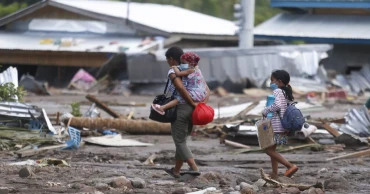storm
Child dies as wall collapses amid Nor’wester in Natore
A 12-year old child died after a wall collapsed during Nor’wester in Baraigram upazila of Natore on Thursday.
The deceased was identified as Bithi Khatun, a student of AgranGanajagaran non-formal Primary School.
Family sourced said when she was washing her hands at the tap inside her home around 8 pm on Wednesday a guava tree and adjacent wall collapsed on her amid storm.
Inspector closed in Natore over July uprising shooting
The family members quickly rescued her and took her to a local private hospital where the doctor declared her dead.
Baraigram Police Station Officer-in-Charge (OC) Golam Sarwar Hossain said police visited the spot upon receiving the news and took legal steps accordingly.
Two locomotives derail in Natore’s Lalpur within span of 7 hrs
7 months ago
Hawaiian airlines flight hits severe turbulence caused by crew's decision to fly over storm
A report from the National Transportation Safety Board (NTSB) concluded that the severe turbulence experienced by a Hawaiian Airlines flight in December 2022 was likely caused by the flight crew's decision to fly over a storm cell, rather than diverting around it. The turbulence, which injured both passengers and crew members, occurred on a flight from Phoenix to Honolulu on December 18, 2022.
According to the NTSB's final report, three passengers and one crew member sustained serious injuries, and a total of 20 people were hurt during the incident. One crew member described the event as reminiscent of a "volcanic explosion," while a passenger who had been in the lavatory at the time of the turbulence reported being violently thrown against the ceiling and then to the floor. Cabin damage included missing ceiling panels, a broken overhead light, and a handset that was shattered into pieces.
Earlier in the investigation, the flight’s captain had told authorities that conditions were calm and the skies were clear when a sudden, towering cloud appeared in front of the plane, resembling a plume of smoke. The crew said they did not have time to change their flight path.
Read: One dead as Singapore Airlines flight from London encounters severe turbulence
The NTSB’s final report stated that meteorological forecasts had predicted unstable weather conditions and isolated thunderstorms for the area, and determined that the crew’s decision to fly over the storm cell—despite warnings of potential severe turbulence—was the probable cause of the accident.
In response to the findings, Hawaiian Airlines said in a statement that it regularly trains its crews to avoid severe weather and turbulence. The airline also stated that after Flight 35, they conducted a thorough internal review and worked closely with the NTSB to understand what led to the unexpected turbulence. "We will continue to learn as much as we can from this event," the airline added.
1 year ago
Nor’wester damages hundreds of houses in Faridpur
Around hundreds of houses were damaged while a number of trees were uprooted during a nor’wester in Faridpur district early Thursday (March 28, 2024).
Twenty villages under Pachuria and Bana unions in Alfadanga upazila of the district were battered by the storm.
Residents of the 20 villages – Sirgram, Garania, Pakuria, Taboni, Tonapara, Sialdi Charpara, Joydebpur, Aushir haat, Kutharakandi, Majpara, Arpara in Bana union; Jugibarat, Bhatpara, Chandra, Pachuria, Deuli, Charnarandia, Dhuljuri and Charbhatpara in Pachuria union – remained in darkness as many electric wires were also snapped during the storm.
A vast track of cropslands were also damaged while trees were uprooted, halting road communications in different parts of the upazila.
Read more: Rains likely in parts of Dhaka, 7 other divisions
AKM Zahidul Hasan Zahid, chairman of Alfadanga upazila, said the storm started sweeping through the upazila around 1 am.
Many people have taken shelter under the open sky as their thatched houses were blown away during the storm.
Additional General Manager of Alfadanga Sub-zonal officer of Palli Bidyut Samity, said some electric poles were uprooted while some wires got snapped, disrupting power connection.
Work is going on to resume power supply, he said.
Quamrul Ahsan Talukdar, deputy commissioner of Faridpur, said directives have been given to provide all-out support to those affected in the storm.
Read more: Women's perspectives are vital in climate action: Environment Minister
1 year ago
How to be Safe During and After Heavy Rains
Rain, a wonderful blessing of mother nature, helps plants grow, fills up the rivers, and keeps the world green and liveable. However, transforming into a powerful storm, heavy rain can bring lightning, thundershowers, and strong winds, which can cause damages to lives and properties. So, understanding how to be safe during and after heavy rains is essential. This article provides a significant to-do list, carrying some practical steps. Let's dive into exploring ways to reduce the risks during heavy rainfall.
Safety Tips during Heavy Rains and Thundershowers
Things to do while Driving
Turn on Headlights
Rain can make it hard for other drivers to see the car. Turning on headlights increases visibility, reducing the risk of accidents.
Don't Attempt to Drive across a Flooded Area
During heavy rains, many roads face water logging. The depth of water can be hard to guess. The gathered water may also hide potholes and electrical wires. Therefore, driving through flooded areas can be risky.
Read more: Ways to Purify Water during Flood, Disaster, Emergency Situations
Reduce Speed Slowly
Wet roads can make tires lose contact with the road surface, a phenomenon known as hydroplaning. To avoid this, vehicles should maintain slower speeds during heavy rain.
Choose Safe Parking Spots
While parking a vehicle, avoid places under power lines, trees, or next to utility poles. These areas can pose risks during heavy rains, like falling branches and debris.
Avoid Driving in Heavy Rain
Poor visibility during heavy rainfall makes driving risky. If possible, drivers should park the vehicle and wait until the rain has slowed down or stopped before continuing the journey.
Read more: Fire Safety in Apartments: Causes and Prevention
2 years ago
Cyclone Preparedness: Safety measures to follow before, during and after disaster
Cyclones are powerful and destructive natural phenomena that can significantly damage life, property, and infrastructure. Being adequately prepared and staying aware of the necessary precautions can greatly minimize the destructive impacts of cyclones on lives and properties.
Unfortunately, unpreparedness and ignorance often exacerbate the effects of these disasters, leading to greater devastation. This article will explore essential cautionary measures before, during, and after a cyclone to save human lives, livestock, and properties.
Precautions before Cyclone
Remember, each cyclone is unique, and the level of preparedness required may vary. Stay vigilant, follow the advice of local authorities, and prioritize safety.
Read more: Cyclone Remal: 500 shelters, 290 medical teams ready in Ctg
Taking proactive measures before a cyclone can significantly reduce its impact and protect lives and property.
Stay informed: Regularly monitor weather forecasts and warnings from reliable sources to stay updated about the cyclone's progress and potential impact on your area.
Develop an emergency plan: Prepare an emergency kit with necessary supplies such as food, water, medication, flashlights, batteries, and a first aid kit. Discuss and practice evacuation routes and procedures with your family.
Secure your property: Trim tree branches, secure loose objects, reinforce doors and windows, and inspect the roof for potential vulnerabilities. In addition, consider installing storm shutters or protective coverings.
Prepare communication channels: Keep mobile phones charged, have a battery-operated radio, and store important documents in waterproof bags. Share contact information with family and friends and establish a communication plan in case of separation.
Evacuation readiness: Familiarize yourself with local evacuation routes and shelters. Plan for the needs of elderly or disabled family members and pets. Follow evacuation orders issued by local authorities promptly.
Safety drills: Conduct regular safety drills with your family members to ensure everyone knows what to do during a cyclone. Practice tasks such as shutting off utilities, assembling the emergency kit, and swiftly reaching the designated safe area.
Secure important documents: Make digital copies of important documents such as identification cards, passports, insurance policies, and property deeds. Store them securely in the cloud or portable device to facilitate easy access and recovery.
Stock up on supplies: Maintain a sufficient supply of non-perishable food items, dry food, bottled water, and necessary medications for several days. In addition, consider the needs of infants, elderly family members, and individuals with special dietary requirements.
Stay hydrated and have snacks: Keep an ample supply of drinking water and non-perishable snacks to sustain you during the cyclone and its aftermath.
Read more: 10 Most Earthquake-prone Countries around the World
2 years ago
Storms, tornadoes slam US South, killing at least 7 people
A giant, swirling storm system billowing across the South on Thursday killed at least six people in central Alabama, where a tornado ripped roofs off homes and uprooted trees in historic Selma, while another person was killed in Georgia, where severe winds knocked out power to tens of thousands of people.
In Autauga County, Alabama, 41 miles (66 kilometers) northeast of Selma, at least six fatalities were confirmed and an estimated 40 homes were damaged or destroyed by a tornado that cut a 20-mile (32-kilometer) path across two rural communities, said Ernie Baggett, the county’s emergency management director.
Several mobile homes were launched into the air and at least 12 people were injured severely enough to be taken to hospitals by emergency responders, Baggett told The Associated Press. He said crews were focused Thursday night on cutting through downed trees to look for people who may need help.
“It really did a good bit of damage. This is the worst that I’ve seen here in this county,” Baggett said.
In Georgia, a passenger died when a tree fell on a vehicle in Jackson during the storm, Butts County Coroner Lacey Prue said. In the same county southeast of Atlanta, the storm appeared to have knocked a freight train off its tracks, officials said.
Democrats question worker safety in Amazon warehouse rebuildNationwide, there were 33 separate tornado reports Thursday from the National Weather Service as of Thursday evening, with a handful of tornado warnings still in effect in Georgia, South Carolina and North Carolina. However, the reports were not yet confirmed and some of them could later be classified as wind damage after assessments are done in coming days.
In Selma, a city etched in the history of the civil rights movement, a tornado cut a wide path through the downtown area, where brick buildings collapsed, oak trees were uprooted, cars were on their side and power lines were left dangling. Plumes of thick, black smoke rose over the city from a fire burning. It wasn’t immediately known whether the storm caused the blaze.
Selma Mayor James Perkins said no fatalities have been reported, but several people were seriously injured. First responders were continuing to assess the damage and officials hoped to get an aerial view of the city Friday morning.
A large tornado damaged homes and uprooted trees in Alabama Thursday as a powerful storm system pushed through the South. (Jan 12) “We have a lot of downed power lines,” he said. “There is a lot of danger on the streets.”
With widespread power outages, the Selma City Council held a meeting on the sidewalk, using lights from cellphones, to declare a state of emergency. A high school was opened as a shelter, officials said.
Mattie Moore was among Selma residents who picked up boxed meals offered by a charity downtown.
“Thank God that we’re here. It’s like something you see on TV,” Moore said of all the destruction.
A city of about 18,000 people, Selma is about 50 miles (80 kilometers) west of the Alabama capital of Montgomery. It was a flashpoint of the civil rights movement and where Alabama state troopers viciously attacked Black people advocating for voting rights as they marched across the Edmund Pettus Bridge on March 7, 1965.
After the tornado passed, Krishun Moore emerged from her home to the sound of children crying and screaming. She and her mother encouraged the kids to keep screaming until they found the two of them on top of the roof of a damaged apartment. She estimated the kids were about 1 and 4 years old. Both of them are OK, she said through Facebook messenger.
Malesha McVay drove parallel to the tornado with her family. She said it got less than a mile (less than 2 kilometers) from her home before suddenly turning.
“We stopped and we prayed. We followed it and prayed,” she said. “It was a 100% God thing that it turned right before it hit my house.”
She took video of the giant twister, which would turn black as it swept away home after home.
“It would hit a house, and black smoke would swirl up,” she said. “It was very terrifying.”
About 40,000 customers were without power in Alabama on Thursday night, according to PowerOutage.us, which tracks outages nationwide. In Georgia, about 86,000 customers were without electricity after the storm system carved a path across a tier of counties just south of Atlanta.
The storm hit in Griffin, south of Atlanta, with winds damaging a shopping area, local news outlets reported. A Hobby Lobby store partially lost its roof, and at least one car was flipped in the parking lot of a nearby Walmart.
Damage was also reported west of downtown Atlanta in Douglas County and Cobb County, with Cobb County government posting a damage report showing a crumbled cinder block wall at a warehouse in suburban Austell.
In Kentucky, the National Weather Service in Louisville confirmed that an EF-1 tornado struck Mercer County and said crews were surveying damage in a handful of other counties.
Three factors — a natural La Nina weather cycle, warming of the Gulf of Mexico likely related to climate change and a decades-long shift of tornadoes from the west to east — came together to make Thursday’s tornado outbreak unusual and damaging, said Victor Gensini, a meteorology professor at Northern Illinois University who studies tornado trends.
The La Nina, a cooling of parts of the Pacific that changes weather worldwide, was a factor in making a wavy jet stream that brought a cold front through, Gensini said. But that’s not enough for a tornado outbreak. What’s needed is moisture.
Normally the air in the Southeast is fairly dry this time of year but the dew point was twice what is normal, likely because of unusually warm water in the Gulf of Mexico, which is likely influenced by climate change. That moisture hit the cold front and everything was in place, Gensini said.
2 years ago
Western NY death toll rises to 28 from cold, storm chaos
Buffalo residents hovered around space heaters, hunted for cars buried in snow drifts and looked for more victims Monday, after 28 people died in one of the worst weather-related disasters ever to hit western New York.
The rest of the United States also was reeling from the ferocious winter storm, with at least another two dozen deaths reported in other parts of the country.
Up to 9 more inches of snow (23 centimeters) could fall in some areas of western New York through Tuesday, the National Weather Service said.
“This is not the end yet,” said Erie County Executive Mark Poloncarz, calling the blizzard “the worst storm probably in our lifetime,” even for an area accustomed to punishing snow.
Some people, he noted, were stranded in their cars for more than two days.
President Joe Biden said his prayers were with the victims’ families, and offered federal assistance Monday to the hard-hit state.
Those who lost their lives around Buffalo were found in cars, homes and snowbanks. Some died while shoveling snow, others when emergency crews could not respond in time to medical crises.
Melissa Carrick, a doula, said the blizzard forced her to coach a pregnant client through childbirth by telephone. An ambulance crew transported the woman to a hospital about 45 minutes south of Buffalo because none of the closer hospitals were reachable.
“In any other normal Buffalo storm? I would just go because that’s what you do – just drive through the snow,” she said. “But you knew this was different.”
Scientists say the climate change crisis may have contributed to the intensity of the storm. That’s because the atmosphere can carry more water vapor, which acts as fuel, said Mark Serreze, director of the National Snow and Ice Data Center at the University of Colorado, Boulder.
Read more: 48 deaths reported in US from massive storm
Victor Gensini, a meteorology professor at Northern Illinois University, likened a single weather event to an “at-bat” — and the climate as your “batting average.”
“It’s hard to say,” Serreze said. “But are the dice a little bit loaded now? Absolutely.”
The blizzard roared across western New York Friday and Saturday. With many grocery stores in the Buffalo area closed and driving bans in place, some people pleaded on social media for donations of food and diapers.
“It was like looking at a white wall for 14 to 18 hours straight,” Poloncarz, the county official, said.
Relief is coming later this week, as forecasts call for temperatures to slowly rise, said Ashton Robinson Cook, a meteorologist with the National Weather Service.
Cook said the bomb cyclone — when atmospheric pressure drops very quickly in a strong storm — has weakened. It developed near the Great Lakes, stirring up blizzard conditions including heavy winds and snow.
Some 3,410 domestic and international flights were canceled Monday as of about 3 p.m. EDT, according to the tracking site FlightAware. The site said Southwest Airlines had 2,497 cancellations — about 60% of its scheduled flights and about 10 times as many as any other major U.S. carrier.
Southwest said the weather was improving, which would “stabilize and improve our situation.”
Based on FlightAware data, airports all across the U.S. were suffering from cancellations and delays, including Denver, Atlanta, Las Vegas, Seattle, Baltimore and Chicago.
New York Gov. Kathy Hochul toured the aftermath in Buffalo — her hometown — on Monday, calling the blizzard “one for the ages.” Almost every fire truck in the city became stranded Saturday, she said.
Hochul noted the storm came a little over a month after the region was inundated with another “historic” snowfall. Between the two storms, snowfall totals are not far off from the 95.4 inches (242 centimeters) the area normally sees in an entire winter season.
Read more: Millions in US hunker down from frigid, deadly monster storm
The National Weather Service said the snow total at the Buffalo Niagara International Airport stood at 49.2 inches (1.25 meters) at 10 a.m. Monday. Officials say the airport will be shut through Wednesday morning.
Shahida Muhammad told WKBW that an outage knocked out power to her 1-year-old son’s ventilator. She and the child’s father manually administered breaths from Friday until Sunday when rescuers saw her desperate social media posts and came to their aid. She said her son was doing well despite the ordeal and described him as “a fighter.”
In a makeshift hut in her living room, Trisha LoGrasso was still huddled around a space heater Monday with three of her children and her eldest daughter’s boyfriend. The temperature inside her Buffalo home was 42 degrees (5.5 C). She was without heat because of a gas leak, and burst pipes left her with no running water.
“I’ve lived here my whole life, and this is the worst storm I’ve ever seen,” the 48-year-old said.
Melissa Osmon and her husband James were without power for more than 72 hours in the Buffalo suburb of Williamsville, and would retreat to their car to stay warm for hours at a time.
“We even watched the Buffalo Bills game on our phone,” Osmon said, speaking by phone from her GMC Acadia.
“You can see your breath inside the house,” she said. “That’s how cold it is.”
The storm knocked out power in communities from Maine to Seattle.
Storm-related deaths were reported practically nationwide, including at least eight killed in crashes in Missouri, Kansas and Kentucky. A woman fell through Wisconsin river ice, and there was a fatal fire at a Kansas homeless persons camp.
In Jackson, Mississippi, crews struggled Monday to get water through the capital city’s beleaguered water system, authorities said. Many areas had no water or low water pressure. On Christmas Day, residents were told to boil their drinking water due to water lines bursting in the frigid temperatures.
“The issue has to be significant leaks in the system that we have yet to identify,” the city said in a statement Monday.
3 years ago
Frigid monster storm across US claims at least 34 lives
Millions of people hunkered down against a deep freeze Sunday to ride out the winter storm that has killed at least 34 people across the United States and is expected to claim more lives after trapping some residents inside houses with heaping snow drifts and knocking out power to tens of thousands of homes and businesses.
The scope of the storm has been nearly unprecedented, stretching from the Great Lakes near Canada to the Rio Grande along the border with Mexico. About 60% of the U.S. population faced some sort of winter weather advisory or warning, and temperatures plummeted drastically below normal from east of the Rocky Mountains to the Appalachians, the National Weather Service said.
Travelers’ weather woes are likely to continue, with hundreds of flight cancellations already and more expected after a bomb cyclone — when atmospheric pressure drops very quickly in a strong storm — developed near the Great Lakes, stirring up blizzard conditions, including heavy winds and snow. Some 1,707 domestic and international flights were canceled on Sunday as of about 2 p.m. EDT, according to the tracking site FlightAware.
The storm unleashed its full fury on Buffalo, with hurricane-force winds and snow causing whiteout conditions, paralyzing emergency response efforts. New York Gov. Kathy Hochul said almost every fire truck in the city was stranded Saturday and implored people Sunday to respect an ongoing driving ban in the region. Officials said the airport would be shut through Tuesday morning. The National Weather Service said the snow total at the Buffalo Niagara International Airport stood at 43 inches (109 centimeters) at 7 a.m. Sunday.
Daylight revealed cars nearly covered by 6-foot snowdrifts and thousands of houses, some adorned in unlit holiday displays, dark from a lack of power. With snow swirling down untouched and impassable streets, forecasters warned that an additional 1 to 2 feet of snow was possible in some areas through early Monday morning amid wind gusts of 40 mph. Police said Sunday evening that there were two “isolated” instances of looting during the storm.
Read more: Millions in US hunker down from frigid, deadly monster storm
Two people died in their suburban Cheektowaga, New York, homes Friday when emergency crews could not reach them in time to treat their medical conditions. County Executive Mark Poloncarz 10 more people died in Erie County during the storm, including six in Buffalo, and warned there may be more dead.
“Some were found in cars, some were found on the street in snowbanks," said Poloncarz. “We know there are people who have been stuck in cars for more than 2 days.”
Freezing conditions and day-old power outages had Buffalonians scrambling to get to anywhere that had heat amid what Hochul called the longest sustained blizzard conditions ever in the city. But with streets under a thick blanket of white, that wasn't an option for people like Jeremy Manahan, who charged his phone in his parked car after almost 29 hours without electricity.
“There’s one warming shelter, but that would be too far for me to get to. I can’t drive, obviously, because I’m stuck,” Manahan said. “And you can’t be outside for more than 10 minutes without getting frostbit.”
Ditjak Ilunga of Gaithersburg, Maryland, was on his way to visit relatives in Hamilton, Ontario, for Christmas with his daughters Friday when their SUV was trapped in Buffalo. Unable to get help, they spent hours with the engine running, buffeted by wind and nearly buried in snow.
By 4 a.m. Saturday, their fuel nearly gone, Ilunga made a desperate choice to risk the howling storm to reach a nearby shelter. He carried 6-year-old Destiny on his back while 16-year-old Cindy clutched their Pomeranian puppy, following his footprints through drifts.
“If I stay in this car I’m going to die here with my kids,” Ilunga recalled thinking. He cried when the family walked through the shelter doors. “It’s something I will never forget in my life."
Read more: Wild winter storm envelops US, snarling Christmas travel
The storm knocked out power in communities from Maine to Seattle. But heat and lights were steadily being restored across the U.S. According to poweroutage.us, less than 200,000 customers were without power Sunday at 3 p.m. EDT — down from a peak of 1.7 million.
Concerns about rolling blackouts across eastern states subsided Sunday after PJM Interconnection said its utilities could meet the day’s peak electricity demand. The mid-Atlantic grid operator had called for its 65 million consumers to conserve energy amid the freeze Saturday.
In North Carolina, less than 6,500 customers had no power — down from a peak of 485,000. Across New England, power has been restored to tens of thousands with just under 83,000 people, mostly in Maine, still without it. In New York, about 34,000 households were still without power Sunday, including 26,000 in Erie County, where utility crews and hundreds of National Guard troops battled high winds and struggled with getting stuck in the snow.
Storm-related deaths were reported in recent days all over the country: 12 in Erie County, New York, ranging in age from 26 to 93 years old, and another in Niagara County where a 27-year-old man was overcome by carbon monoxide after snow blocked his furnace; 10 in Ohio, including an electrocuted utility worker and those killed in multiple car crashes; six motorists killed in crashes in Missouri, Kansas and Kentucky; a Vermont woman struck by a falling branch; an apparently homeless man found amid Colorado's subzero temperatures; and a woman who fell through Wisconsin river ice.
In Jackson, Mississippi, city officials on Christmas Day announced that residents must now boil their drinking water due to water lines bursting in the frigid temperatures
In Buffalo, William Kless was up at 3 a.m. Sunday. He called his three children at their mother’s house to wish them Merry Christmas and then headed off on his snowmobile for a second day spent shuttling people from stuck cars and frigid homes to a church operating as a warming shelter.
Through heavy, wind-driven snow, he brought about 15 people to the church in Buffalo on Saturday, he said, including a family of five transported one-by-one. He also got a man in need of dialysis, who had spent 17 hours stranded in his car, back home, where he could receive treatment.
“I just felt like I had to,” Kless said.
3 years ago
Storm blowing through California dumps snow in Sierra
Heavy snow fell in the Sierra Nevada as a winter storm packing powerful winds sent ski lift chairs swinging and closed mountain highways while downpours at lower elevations triggered flood watches Sunday across large swaths of California into Nevada.
More than 250 miles (400 km) of the Sierra from north of Reno south to Yosemite National Park remained under winter storm warnings either until late Sunday or early Monday.
The Heavenly ski resort at Lake Tahoe shut down some operations when the brunt of the storm hit Saturday. The resort posted video of lift chairs swaying violently because of gusts that topped 100 mph (161 kph), along with a tweeted reminder that wind closures are "always for your safety.”
To the south, Mammoth Mountain reported that more than 20 inches (51 cm) of snow fell Saturday, with another 2 feet (.6 meters) possible as the tail end of the system moved through the eastern Sierra.
Read more: Heavy rain, wind, snow blows through California into Sierra
The UC Berkeley Central Sierra Snow Lab in Soda Springs, California reported Sunday morning that more than 43 inches (110 cm) had fallen in a 48-hour span.
A 70-mile (112-km) stretch of eastbound U.S. Interstate 80 was closed Saturday “due to zero visibility” from the northern California town of Colfax to the Nevada state line, transportation officials said. Chains were required on much of the rest of I-80 and other routes in the mountains from Reno toward Sacramento.
Many other key roads were closed because of heavy snow, including a stretch of California Highway 89 between Tahoe City and South Lake Tahoe, the highway patrol said.
The U.S. Forest Service issued an avalanche warning for the backcountry in the mountains west of Lake Tahoe where it said “several feet of new snow and strong winds will result in dangerous avalanche conditions.”
Gusts up to 50 mph (80 kph) that sent trees into homes in Sonoma County north of San Francisco on Saturday could reach 100 mph (160 kph) over Sierra ridgetops on Sunday, the National Weather Service said.
Read more: Storm’s fierce winds complicate California wildfire fight
Heavy rain was forecast through the weekend from San Francisco to the Sierra crest with up to 2 inches (5 cm) in the Bay Area and up to 5 inches (13 cm) at Grass Valley northeast of Sacramento.
Warnings and watches were also up across Southern California, as heavy rain caused localized flooding in greater Los Angeles.
“Significant travel delays possible with accumulating snow on several mountain roads. This could include the Tejon Pass and Grapevine area of Interstate 5,” the National Weather Service's LA-area office said in a statement.
Forecasters in Arizona issued a winter storm watch for northern and central Arizona beginning Sunday evening for areas above 5000 feet (1,525 meters) including Flagstaff, Prescott and the Grand Canyon, where icy temperatures and up to a foot of snow was predicted.
As the storm exits the U.S. West, it will push across the country and reach the Plains by mid-week, bringing significant rain and below-average temperatures, said Marc Chenard, meteorologist at the National Weather Service at the national center in College Park, Maryland.
“It will be a busy week while this system moves across the country,” Chenard said Sunday.
3 years ago
Nearly 100 dead, dozens missing as storm lashes Philippines
Nearly 100 people have died in one of the most destructive storms to lash the Philippines this year with dozens more feared missing in a mudslide-hit mountainside village, while more than a million others were swamped by floodwater in several provinces, officials said Monday.
At least 53 of 98 people who died — mostly in flooding and landslides — were from Maguindanao in the Bangsamoro autonomous region, which was swamped by unusually heavy rains set off by Tropical Storm Nalgae. The storm blew out of the country and into the South China Sea on Sunday, leaving a trail of destruction in a large swath of the archipelago.
A large contingent of rescuers with bulldozers and backhoes resumed retrieval work in southern Kusiong village in the hard-hit province of Maguindanao, where as many as 80 to 100 people, including entire families, are feared to have been buried by a boulder-laden mudslide or swept away by flash floods that started overnight Thursday, said Naguib Sinarimbo, the interior minister for a Muslim autonomous region run by former separatist guerrillas under a peace pact.
The government’s main disaster-response agency also reported 69 people were injured in the onslaught and at least 63 others remain missing.
More than 1 million people were lashed by the storm, including more than 912,000 villagers who fled to evacuation centers or homes of relatives. More than 4,100 houses and 16,260 hectares (40,180 acres) of rice and other crops were damaged by floodwaters at a time when the country was bracing for a looming food crisis because of global supply disruptions, officials said.
Sinarimbo said the official tally of missing people did not include most of those feared missing in the huge mudslide that hit Kusiong because entire families may have been buried and no member was left to provide names and details to authorities.
The catastrophe in Kusiong, populated mostly by the Teduray ethnic minority group, was particularly tragic because its more than 2,000 villagers have carried out disaster-preparedness drills every year for decades to brace for a tsunami because of a deadly history. But they were not as prepared for the dangers that could come from Mount Minandar, where their village lies at the foothills, Sinarimbo said.
“When the people heard the warning bells, they ran up and gathered in a church on a high ground,” Sinarimbo told The Associated Press on Saturday, citing accounts by Kusiong villagers.
“The problem was, it was not a tsunami that inundated them but a big volume of water and mud that came down from the mountain,” he said.
In August 1976, an 8.1-magnitude earthquake and a tsunami in the Moro Gulf that struck around midnight left thousands of people dead and devastated coastal provinces in one of the deadliest natural disasters in Philippine history.
Lying between the Moro Gulf and 446-meter (1,464-foot) Mount Minandar, Kusiong was among the hardest hit by the 1976 catastrophe. The village never forgot the tragedy. Elderly villagers who survived the tsunami and powerful earthquake passed on the nightmarish story to their children, warning them to be prepared.
“Every year, they hold drills to brace for a tsunami. Somebody was assigned to bang the alarm bells and they designated high grounds where people should run to,” Sinarimbo said. “Villagers were even taught the sound of an approaching big wave based on the recollection of the tsunami survivors.”
“But there wasn’t as much focus on the geo-hazards on the mountainside,” he said.
Bulldozers, backhoes and payloaders were brought to Kusiong on Saturday with more than 100 rescuers from the army, police and volunteers from other provinces, but they were unable to dig at a spot where survivors said the church lay underneath because the muddy mound was still dangerously soft, officials said.
The stormy weather in a large swath of the country hindered transportation as millions of Filipinos planned to travel over a long weekend for visits to relatives’ tombs and for family reunions on All Saints’ Day in the largely Roman Catholic nation.
Nearly 200 domestic and international flights were canceled, Manila’s international airport was briefly closed amid stormy weather and voyages in storm-whipped seas were prohibited by the coast guard, stranding thousands of passengers.
Floodwaters swamped many provinces and cities, trapping some people on their roofs. President Ferdinand Marcos Jr. expressed disappointment over the high casualty toll in a televised meeting Saturday with disaster-mitigation officials.
“We should have done better,” Marcos Jr. said. “We were not able to anticipate that the volume of water will be that much so we were not able to warn the people and then to evacuate them out of the way of the incoming flash floods.”
About 20 typhoons and storms batter the Philippine archipelago each year. It is located on the Pacific “Ring of Fire,” a region along most of the Pacific Ocean rim where many volcanic eruptions and earthquakes occur, making the nation one of the world’s most disaster-prone.
3 years ago



















